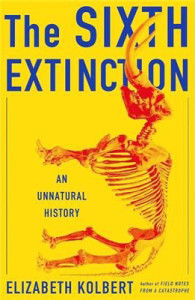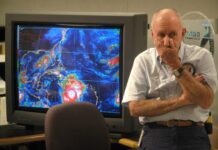(Editor’s Note: Summer Reading is a new Weekly column featuring what local notables are reading this season. What are you reading? Email sara@keysweekly.com.)
George Neugent
Monroe County Commissioner George Neugent has a bunch of books on his bedside table, but he’s currently enthralled by “The Sixth Extinction.”
“It’s not a bunch of gobleygook and heavy science, but it’s documented evidence by a lot of smart people in the field,” Neugent said. “It’s about what’s happened in the past as far as extinctions and where we headed, plus it touches on coral reefs. I’m two-thirds of the way through it. Great book.”
____________________
 The Sixth Extinction: An Unnatural History
The Sixth Extinction: An Unnatural History
By Elizabeth Kolbert
Henry Holt and Co., 2014
Reviewed by Laura Albritton
Don’t let “The Sixth Extinction’s” gloomy title scare you off Elizabeth Kolbert’s new book. Because not only is Kolbert a crack writer (with a day gig at the New Yorker magazine), this volume also contains some fantastically intriguing history and science. The writer’s basic premise is that five, whopping big extinctions of multiple species have occurred in the history of our planet, with a sixth one looming on the horizon.
There’s no denying that Kolbert is tackling a serious subject, as she acknowledges up front: “If extinction is a morbid topic, mass extinction is, well, massively so.” But her writing is enjoyably colorful and entertaining; on a field trip in Panama, she notices that, “Golden frogs have a distinctive, ambling gait that makes them look a bit like drunks trying to walk a straight line.” Her humor makes the more sobering episodes — like when three Icelanders rowed ashore a tiny island and strangled the world’s last two great auks — more bearable.
Although the “Big Five” mass extinctions covered hundreds of millions of years, Kolbert doesn’t start at the beginning and methodically creep forward, like an old science textbook. Instead, she tells stories, about, for example, the French baron Charles le Moyne who discovered the first mastodon tooth in Ohio in 1739, and guarded it despite losing a war against the Chickasaw and near starvation, or Jean Cuvier, who used the tooth to deduce a natural catastrophe had caused the mastodon’s extinction.
Kolbert explains that for years the scientific camp was divided between those who thought mass extinctions occurred very gradually, and those who believed they were caused by huge, catastrophic events. The book traces how the catastrophists have often been proven right, and forecasts a sixth extinction is already underway, produced by the profound alterations we human beings are making to our atmosphere. A paper published in Nature suggested “if current trends continue, then by around 2050 visitors to the Great Barrier Reef will arrive to find ‘rapidly eroding rubble banks.’” Alarming predictions, yes, in a book that’s one heck of a read.
Laura Albritton writes about books and art for publications such as the Miami Herald and Sculpture magazine. University Press of Florida recently published her guidebook, Miami for Families: A Vacation Guide for Parents and Kids (www.MiamiForFamilies.com).






















